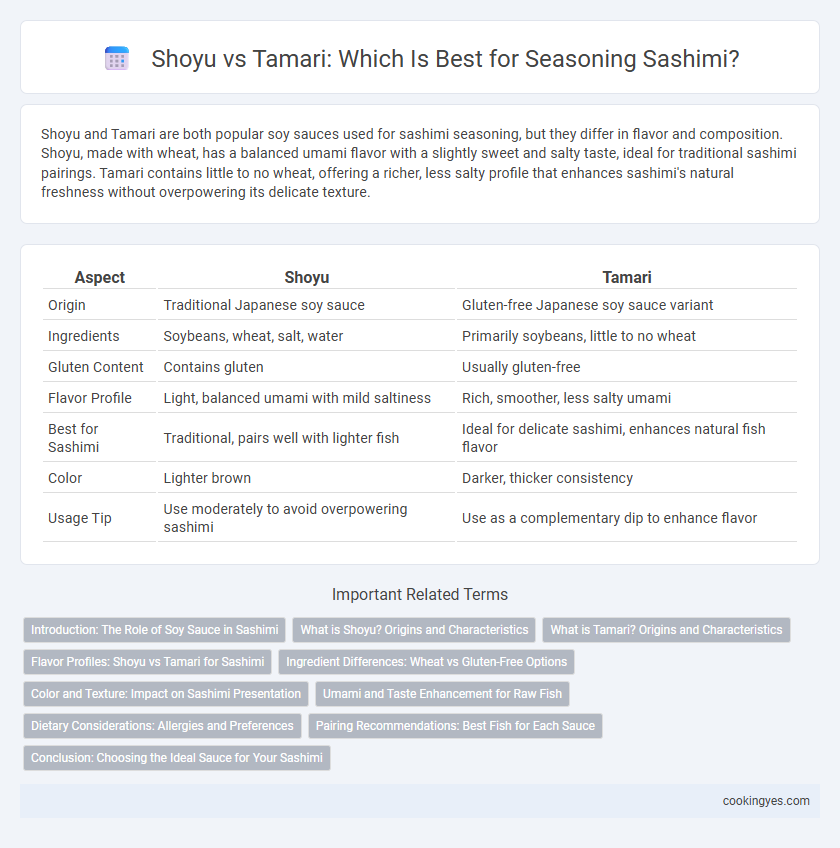Shoyu and Tamari are both popular soy sauces used for sashimi seasoning, but they differ in flavor and composition. Shoyu, made with wheat, has a balanced umami flavor with a slightly sweet and salty taste, ideal for traditional sashimi pairings. Tamari contains little to no wheat, offering a richer, less salty profile that enhances sashimi's natural freshness without overpowering its delicate texture.
Table of Comparison
| Aspect | Shoyu | Tamari |
|---|---|---|
| Origin | Traditional Japanese soy sauce | Gluten-free Japanese soy sauce variant |
| Ingredients | Soybeans, wheat, salt, water | Primarily soybeans, little to no wheat |
| Gluten Content | Contains gluten | Usually gluten-free |
| Flavor Profile | Light, balanced umami with mild saltiness | Rich, smoother, less salty umami |
| Best for Sashimi | Traditional, pairs well with lighter fish | Ideal for delicate sashimi, enhances natural fish flavor |
| Color | Lighter brown | Darker, thicker consistency |
| Usage Tip | Use moderately to avoid overpowering sashimi | Use as a complementary dip to enhance flavor |
Introduction: The Role of Soy Sauce in Sashimi
Soy sauce plays a crucial role in enhancing the delicate flavors of sashimi, offering a savory and umami-rich complement to the fresh fish. Shoyu, a traditional Japanese soy sauce made from fermented soybeans and wheat, provides a balanced salty and slightly sweet taste that pairs well with various sashimi types. Tamari, a wheat-free soy sauce variant made primarily from soybeans, delivers a richer, more intense umami flavor ideal for those with gluten sensitivities or seeking a robust seasoning alternative.
What is Shoyu? Origins and Characteristics
Shoyu is a traditional Japanese soy sauce made from fermented soybeans, wheat, water, and salt, originating from ancient China but refined in Japan for centuries. It offers a balanced, slightly sweet, and savory flavor with a lighter color and thinner consistency compared to Tamari. Shoyu's umami-rich profile enhances sashimi by complementing the delicate fish without overpowering its natural taste.
What is Tamari? Origins and Characteristics
Tamari is a traditional Japanese soy sauce originating from the Chubu region, specifically associated with the production of miso. It is thicker, darker, and less salty than regular shoyu, with a rich umami flavor due to higher soy content and minimal wheat, making it suitable for gluten-free diets. This distinct profile enhances sashimi by complementing the fish's delicate taste without overpowering its natural flavors.
Flavor Profiles: Shoyu vs Tamari for Sashimi
Shoyu offers a balanced umami flavor with a slightly sweet and salty profile that complements the delicate taste of sashimi without overpowering it. Tamari, often richer and less salty than shoyu, provides a deeper, more robust umami taste ideal for enhancing the natural flavors of fatty fish like tuna or salmon. Both soy sauces highlight sashimi differently, with shoyu's lighter texture preserving subtle freshness and tamari's thicker consistency adding depth to each bite.
Ingredient Differences: Wheat vs Gluten-Free Options
Shoyu and tamari differ primarily in their wheat content, with traditional shoyu containing soy and wheat, making it unsuitable for gluten-free diets. Tamari is a wheat-free soy sauce alternative, crafted mainly from soybeans, offering a rich umami flavor ideal for sashimi seasoning. Choosing tamari ensures a gluten-free option without compromising the classic savory taste essential to authentic sashimi enjoyment.
Color and Texture: Impact on Sashimi Presentation
Shoyu's lighter color provides a translucent, amber hue that enhances sashimi's vibrant appearance, while tamari's darker, richer tone creates a striking contrast that emphasizes the fish's natural colors. Tamari offers a thicker, silkier texture that clings smoothly to sashimi slices, improving mouthfeel and visual appeal, whereas shoyu's thinner consistency results in a more delicate coating. The choice between shoyu and tamari directly affects sashimi presentation by influencing both the visual intensity and tactile experience of the seasoning.
Umami and Taste Enhancement for Raw Fish
Tamari offers a richer umami profile compared to shoyu, making it ideal for enhancing the delicate flavors of sashimi without overpowering the raw fish. Its lower sodium content allows the natural sweetness and subtle textures of sashimi to shine, while providing a smooth, balanced taste. Shoyu delivers a more salty and slightly tangy flavor that can complement heartier cuts but may mask the subtle nuances of premium sashimi.
Dietary Considerations: Allergies and Preferences
Shoyu and tamari differ significantly in their allergen profiles, with tamari being typically gluten-free and more suitable for individuals with gluten intolerance or celiac disease. Shoyu contains wheat, which may pose risks for those with gluten allergies or sensitivities. Choosing tamari for sashimi seasoning accommodates dietary restrictions while preserving the umami flavor essential to this traditional Japanese dish.
Pairing Recommendations: Best Fish for Each Sauce
Shoyu is a versatile soy sauce with a balanced salty and umami flavor that pairs exceptionally well with fatty sashimi like salmon and tuna, enhancing their rich textures without overpowering. Tamari, a gluten-free soy sauce variant with a deeper, less salty profile, complements delicate white fish such as flounder and yellowtail, allowing their subtle flavors to shine. For the best sashimi experience, choose shoyu with robust fish and tamari with milder varieties to achieve optimal seasoning balance.
Conclusion: Choosing the Ideal Sauce for Your Sashimi
Shoyu and Tamari each offer distinct flavor profiles for sashimi seasoning, with Shoyu providing a balanced, slightly sweet umami taste, and Tamari delivering a richer, gluten-free option with a deeper, less salty flavor. Selecting the ideal sauce depends on dietary preferences and desired taste intensity, making Shoyu suitable for traditional palates and Tamari ideal for those seeking a gluten-free or more robust experience. Prioritizing quality, gluten content, and flavor harmony ensures the perfect complement to fresh sashimi.
Shoyu vs Tamari for sashimi seasoning Infographic

 cookingyes.com
cookingyes.com